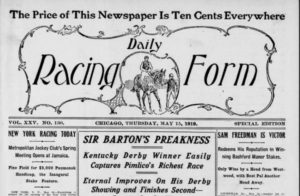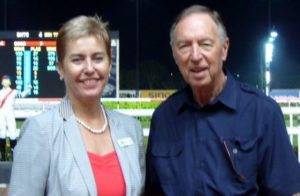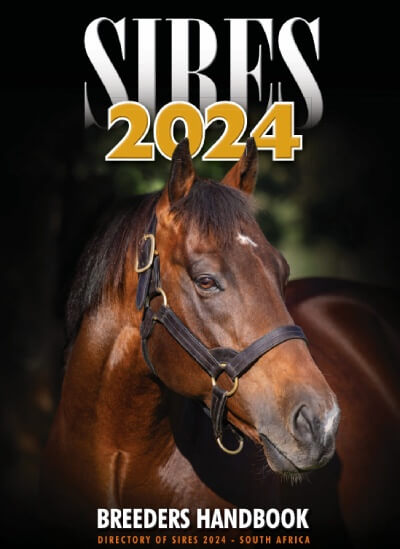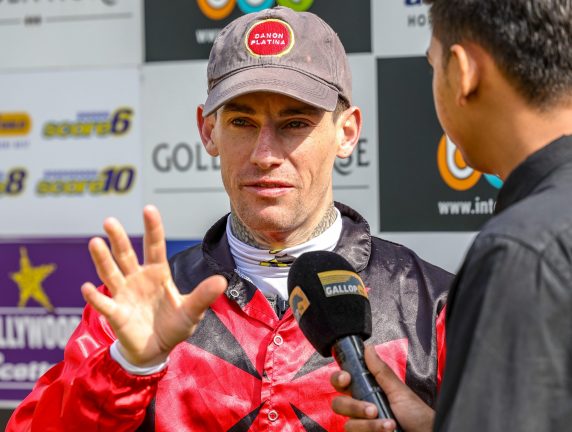The Daily Racing Form (affectionately called the DRF) was founded in 1894 by Frank Brunell. Brunell felt that in order to punt successfully, he needed more information than was being disseminated at the time and so he devised and published racing charts. The first edition was published on 17 November 1894 as a 4-page broadsheet. In 1905 he added a past performances record for each horse in a race and these two vital sets of racing information have remained largely unchanged since their original design.
Publishing up to 2,000 unique pages of statistical and editorial copy every day, in as many as 30 daily editions, 364 days a year (with the exception of Christmas Day) and sold at over 12,000 retail outlets nationwide and at every racetrack and pari-mutuel venue that accepts wagers on Thoroughbred racing, it was known as America’s Turf Authority or simply ‘the bible’. ROBYN LOUW was thrilled to meet George Bernet, the man who helped write and edit ‘the bible’ for 30 years.
George Bernet
If a soft New Jersey accent exists, then George has one, although it sharpens if a story requires intrigue and rounds out when he reminisces fondly and it is frequently punctuated by a chuckle or a laugh. George was born on 9 October 1942 in Newark, New Jersey. He says he once worked it back and figured out he was conceived shortly after Pearl Harbour. His grandfather was George snr, his father was George jnr and so he was George the 3rd, although he confides that his father drove a 1941 Packard Clipper, so he was nicknamed Skipper, after the car and no-one ever called him George.
Racing family
After the war, 3 racetracks opened up locally – Monmouth Park, Garden State Park and Atlantic City, with Aqueduct and Belmont also within easy reach. His dad loved racing and he loved driving and the family would go racing together regularly. “Mom’s birthday was on August 4th, so she loved to play numbers 8 and 4. She won often too – it drove my dad nuts. Johnny Sellers was her favourite jockey and one day, he won the first race and mom wanted to bet on him to win again in the second. My dad said she was crazy. Of course, Johnny won 6 out of 8 races that day and my mom went home with fistfuls of dollars. It nearly killed him!”
George remembers his first bet. “It was 1954 on Pet Bully. He was a son of Bull Lea and I was 12 years old. My dad bet $2 for me at 5-1. The horse won. Dad took a commission to teach me a lesson!” By 14 he was an old hand at reading form.
“I grew up in Roselle Park and graduated in 1960. I enrolled at Rutgers University and because I got a perfect SAT score, I didn’t need to take freshman English, so I took a course in newswriting instead. I needed to pay my way through college and got a job as a copyboy at the Star Ledger. I ended up doing selections and writing and was eventually working 5 days a week. In 1961 the racing editor took me to Monmouth Park and introduced me to the local trainers. In those years, there were no women allowed in the press box – even the cleaning staff were male. But I realised the press box was on the same level as the stewards and caller. They were the best seats in the house – and that was it!”
I joined the Morning Telegraph on 8 December 1968. The offices were on 52nd Street, New York, which was the Hell’s Kitchen district, but I loved it. There was a bookmaker on every floor and everyone’s heads were just constantly in racing. In 1971, the offices moved to Hightstown on the New Jersey Turnpike for ease of distribution and in 1972 we published as the Daily Racing Form for the first time. We had staff at every racetrack across the country and we were the only collector of racing data in the US. If you want to be a punter, you have to know stuff. We had access to information no-one else had and it was fantastic. I was a history major at college and had learnt to research, so I could interpret the information. I got really good at the first crop sires and made a fair bit of money. I’d always buy something special if I had a big win and I bought new tv’s, new stereos…”
Favourites
George worked under the legendary Joe Hirsch, the “dean” of Thoroughbred racing writers. He saw Northern Dancer in action and his wife danced with Horatio Luro, ‘El Gran Senor’ himself, at one of the racing functions. He saw Secretariat’s Triple Crown campaign and had his money on Onion in the Whitney. However, his favourite horse of all time is Kelso. “He was horse of the year 5 times in a row and the only horse to run 2 miles in under 3:19 2/5’s. Twice. He set the record in 1960 and broke it in 1964. He won over 6 furlongs too. He was just one of those special horses. Kelso was tough and he was mean and he wanted to win. He was kinda ugly looking and his bones stuck out, but his coat glowed with good health and as Hall of Famer Woody Stephens once said “This ain’t no beauty contest!” He had two nemeses – Beau Purple and Gun Bow. In the Woodward, Kelso ran wide and tried to savage Gun Bow to stop him from getting past. It was one of the closest finishes of all time. They called for the photo and really took their time over it. I heard Gun Bow’s trainer, Eddie Neloy say ‘I’ll take a dead heat’. A hair separated them and they gave the race to Gun Bow. To show there were no hard feelings, I went back to the barn and fed Gun Bow some carrots. When they met again a few weeks later in the Aqueduct Handicap, Kelso paid $6.60. I bet $50 and he beat Gun Bow home comfortably.”
Favourite jockey
“Yves St Martin. He somehow just always managed to get around everyone and place his horse exactly where he wanted him, on the rail and saving every inch and he wouldn’t move a muscle. When he was ready, he’d just sort of pick the horse up and pass everyone and off they’d go. As the old saying goes, the good jockeys don’t need instructions, the bad ones don’t listen anyway.”
Favourite Trainer
“Jonathan Sheppard. He’s just such an honourable, honest person. His horse Flatterer is the only one to win the American steeplechase Triple Crown, and he was the only horse to win the Eclipse Award for outstanding Steeplechase horse four years in a row. Jonathan has won at least one race in every annual Saratoga meet since 1969. It’s a record streak.”
And he has a soft spot for the old timers. “Those guys knew horses, especially the steeplechase guys. They’re used to having horses till they’re 9 or 10, so they had patience. And they have patient clients. They’d plan ahead and pick a specific race and aim a horse for that. The rest were usually just what we liked to call ‘public gallops’. Of course, the public never knew when it was a practice and when it was real, so you had to learn to ‘handicap’ the trainer.
Mind you, it doesn’t always work out. Phillip England once told me ‘Plan A is the trainer’s plan, Plan B is the jockey’s plan, and Plan C is the horse’s plan. Mostly we go with Plan C.’ When Thornfield drew post 14 for the 1999 Breeders’ Cup Turf, he said ‘We’ll have to go with Plan B. Problem is, there is no plan B.” Thornfield finished 13th.
Favourite track
“Monmouth Park, it’s my local track and it’s known as the ‘resort of racing’. Everything is white and green paint and it looks like summer. There are people who’ve been going since the track opened in 1946, as have some of the mutual clerks. There’s a big picnic area and people can bring wine and food and there’s a playground for the kids. Sundays are family fun days and they have clowns and face-painting and pony rides. The track was owned by Amory Haskell and first post was always 2:30pm. Amory liked to play golf in the morning and that allowed him enough time to play golf, have lunch and be at the track for the first post. It was the first US track to have luxury parterre boxes. The architect was Chinese and had been to Happy Valley where the Brits had built boxes high up, away from the regular punters and so he built 3 levels of boxes at Monmouth.”
Were horses tougher back then?
“I think so. For the most part, people weren’t breeding for precocity back then. With the advent of raceday medication, I think horses have become more fragile and less sound. Horses have soundness issues masked by drugs and then end up in the breeding shed. Unsound stallions pass on unsoundness. It eventually shows up.
Take a horse like Citation. He was on his Triple Crown campaign and between the Preakness and his Belmont run, Jimmy Jones runs him in a mile stakes race and he goes and wins that. I asked Jimmy about it and he said, ‘I was gonna work him a mile anyway. They put up $50k – what was I supposed to do?’
“A guy by the name of Hirsch Jacobs was our leading breeder, owner and trainer for 3 years running. He’d always say ‘they don’t make money standing in their stalls.’ His daughter Patrice had a horse called Bonjour. My mother loved the name and wanted to go to the track every time he ran. We went to the first few, but he ran practically every 10 days, so we eventually gave up.”
Do you think the sport is dying?
“A lot of ships have sailed for racing, but in the US alone we bet $25-30 million a day on racing. Despite the lottery and casinos, all over the world people still prefer to bet on horses because it’s a cerebral game and the possibilities are endless. And people still respond to name horses. Horses like Zenyatta and California Chrome prove that we still have something to sell.”
Ups and downs of being press?
“The hardest was part was getting quotes from losing trainers. Some guys are easy and you love them, some guys are difficult. The good ones know that dealing with the press is part of the game and part of their success – good PR is good for everyone – but if I found someone being mean to their horses or their staff, they got no more ink. Owners also like recognition. We always wrote it as ‘Mr so-and-so’s horse’. One year, there was a horse called Pink Tights. It won a lot and we kept writing Mr so-and so’s Pink Tights’. It drove him crazy! He wrote in and asked us to stop, so we changed it to ‘Pink Tights, the horse of…’
“The press is important – someone has to keep the game honest and in a free press someone should be able to say when things aren’t working. It’s easy to find the bad – humans all have their frailties – but you can’t let yourself get jaded or cynical. To be a good turf writer, you have to keep your passion for the game. If you can do that, well, I always say I’ve never worked a day in my life. Racing is still the greatest game played outdoors.”










